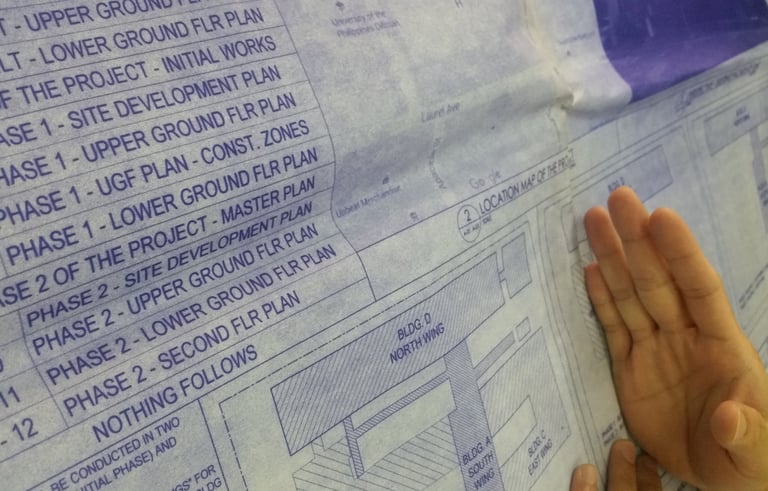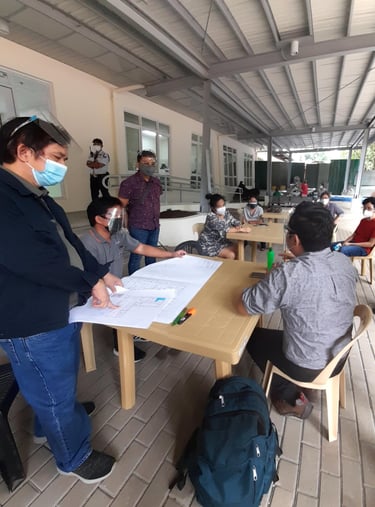What to Look for in a Primary Healthcare Community Center
What is a primary healthcare center? This post delves into what types of healthcare spaces may be found in a primary healthcare hub. As a "first contact" space, such centers make healthcare feel more accessible and friendly to the community around them.
SPACE
Richard Lasam
5/13/20254 min read


Back in 2014, during my Masteral Studies, my group of fellow architects was given the task of formulating a concept study for the redevelopment of our university’s primary healthcare facility: The University Health Service of the University of the Philippines (Diliman Campus), or the UHS for short. This facility mainly caters to the needs of the students, teachers, staff, and community residents of the campus grounds and has needed a makeover over the decades of its operations.
Those initial studies eventually led to me being involved as one of the architects of the design team that implemented the design from 2016 to 2024 (the length of the design and construction of the changes can be attributed to the need to keep the facility operational, as well as COVID-19 disruptions from 2020 to 2022). What I learned from that experience, I wrote in previous articles about design flaws in healthcare facilities that need to be addressed and how primary healthcare is a necessity rather than a luxury.
The UHS is an example of a community-based Primary Health Care Facility, a health space designed to specifically provide healthcare services to the community around it. While this type is not a common health space to see, it is the type of “first contact” healthcare space that should be more available to people, as these types of spaces can promote both better healthcare and health awareness. A Primary Health Care Facility is not necessarily a hospital level space, meaning it is possible that it does not have inpatient services and fully focuses on mostly outpatient activities, but this is also dependent on the needs of the community within which it is located.


tHE OLD UHS BUILDING IN 2014.


SCREENSHOTS OF THE PLANS AND DESIGN.


OUR WORKING TEAM BACK IN 2020. MEETINGS TOOK PLACE OUTSIDE, USING THE SPACES I HAD INTENDED FOR SURGE EVENTS, TO HELP MINIMIZE THE SPREAD OF INFECTIOUS DISEASES.
In this type of care facility, what spaces should you expect to be available? The spaces can be divided into the following:
PUBLIC SPACE
Common Zone. Spaces that promote interaction with the community, allowing the healthcare space to have a more friendly relationship with the people who live adjacent to the building.
-Amenities that promote visiting the Primary Health Care Facility like restaurants, cafes, or stores;
-Wellness spaces such as gyms, swimming pools, playgrounds, and other activities that promote healthy active activities;
-Places for spiritual contemplation such as a chapel or meditation areas;
-Spaces like a multipurpose hall or similar can also allow the healthcare space to host activities and events for the community; and
-Open-air green spaces to promote a natural and inviting atmosphere.
Outer Zone. Spaces that are directly medical in nature that are the services that directly interact with the community.
-Emergency Department or Urgent Care Center for patients who need immediate assistance. The size and population of the community dictate whether an Emergency Department or an Urgent Care Center (or even both!) are needed.
-Doctors clinics. As discussed in a previous article (https://www.spaceandcare.com/outpatient-spaces-doctors-clinic ) these are areas where doctors can have private consultations and even treatments with their respective patients. The clinics should come in a variety of sizes, as some disciplines would need bigger spaces for medical equipment that others.
-Physical Therapy Center and other such departments. Long term type care is quite beneficial to be adjacent to a community, as the services can then be accessed by patients at a much faster rate since travel time is reduced. Staff can even offer services to patients who may not want to leave their home at all, and can have services be done within the comfort of their houses.
-Dental services. Always a necessity in communities as having this service in the healthcare space will be another way to improve the quality of life for the patients.
-Specialist out-patient care services. Certain types of care like dialysis centers, cancer care, and other such healthcare services can also be located in a community primary health care facility to reduce travel time for the patients of the area.
Intermediate Zone. Spaces that are for those who have gone for medical consultations and then need to access other medical services such as diagnostic tests or medicines.
-Diagnostics: Imaging and Laboratory. Having X-Ray, CT scan, and laboratory services near their homes will allow patients to be able to get their healthcare services done more conveniently.
-Pharmacy. With the same reasoning as diagnostics, having your medications prepared near your homes will always be a good service to have.
PRIVATE SPACE
Inner Zone. Spaces for patients that need to stay much longer than usual and would need some privacy.
-Inpatient spaces. If the community has patients that may need to be monitored for longer than 24 hours, the healthcare space may benefit from having a certain number of patient beds.
Deep Zone. Also a private space, the deep zone is not accessible by the public but only by medical staff and the inpatient.
-Birthing spaces. Being in a community setting, their will be a need to provide spaces for childbirth, postpartum care, and childcare so that mothers and fathers need not travel so far from their homes to access these types of services.
Having community-based primary health care centers like these in various parts of cities, towns, and rural areas can greatly increase the reach of healthcare providers.
While there are certainly challenges in terms of staffing, funding, and locating these spaces in a way that will not interfere with hospitals and other such facilities, it is still an idea that is worth exploring, as a properly designed, maintained, and staffed community health care facility can potentially improve the overall health and quality of life in the communities they serve.
